Spatio-Temporal Changes, Trade-Offs and Synergies of Major Ecosystem Services in the Three-River Headwaters Region from 2000 to 2019
Abstract
1. Introduction
2. Materials and Methods
2.1. Study Area
2.2. Data and Processing
2.2.1. Meteorological Data
2.2.2. Fraction Vegetation Coverage
2.2.3. Hydrological Monitoring Data
2.2.4. Other Data
2.3. Total Research Approach
2.4. Ecosystem Services Accounting Method
2.4.1. Water Retention
2.4.2. Soil Retention
2.4.3. Windbreak and Sand Fixation
2.4.4. Forage Supply
2.5. Trend and Significance Test
2.6. Methods for Determining Ecosystem Service Trade-Offs and Synergies
2.7. Dominance Analysis of Ecosystem Services’ Influencing Factors
3. Results
3.1. Spatial–Temporal Characteristics of Ecosystem Services
3.1.1. Water Retention Service
3.1.2. Soil Retention Service
3.1.3. Windbreak and Sand Fixation Service
3.1.4. Forage Supply Service
3.2. Trade-Off and Synergy Relationships of Ecosystem Services
4. Discussion
4.1. Spatial Differences of Ecosystem Services’ Dominance Factors
4.1.1. Water Retention
4.1.2. Soil Retention
4.1.3. Windbreak and Sand Fixation
4.1.4. Forage Supply
4.2. The Impact of Trade-Offs and Synergies on Future Ecological Engineering
5. Conclusions
Author Contributions
Funding
Data Availability Statement
Conflicts of Interest
References
- Costanza, R.; Darge, R.; Groot, R.D. The value of the world’s ecosystem services and natural capital. Nature 1997, 387, 253–260. [Google Scholar] [CrossRef]
- Daily, G. Nature’s Services: Societal Dependence on Natural Ecosystems; Island Press: Washington, DC, USA, 1997. [Google Scholar]
- Millennium Ecosystem Assessment. Ecosystems and Human Well-being; Island Press: Washington, DC, USA, 2005. [Google Scholar]
- Fu, B.J.; Zhang, L.W. Land-use change and ecosystem services: Concepts, methods and progress. Prog. Geogr. 2014, 33, 441–446. (In Chinese) [Google Scholar]
- Peterson, G.D.; Harmackova, Z.V.; Meacham, M. Welcoming different perspectives in IPBES: “Nature’s contributions to people” and “Ecosystem services”. Ecol. Soc. 2018, 23, 307–312. [Google Scholar] [CrossRef]
- Stevenson, H.; Auld, G.; Allan, J.I. The Practical Fit of Concepts: Ecosystem Services and the Value of Nature. Glob. Environ. Polit. 2021, 21, 3–22. [Google Scholar] [CrossRef]
- Fu, B.J.; Yu, D.D. Trade-off analyses and synthetic integrated method of multiple ecosystem services. Resour. Sci. 2016, 38, 1–9. (In Chinese) [Google Scholar]
- Haase, D.; Schwarz, N.; Strohbach, M.; Kroll, F.; Seppelt, R. Synergies, Trade-offs, and Losses of Ecosystem Services in Urban Regions: An Integrated Multiscale Framework Applied to the Leipzig-Halle Region, Germany. Ecol. Soc. 2012, 17, 102–123. [Google Scholar] [CrossRef]
- Li, S.C.; Zhang, C.Y.; Liu, J.L.; Zhu, W.B.; Ma, C.; Wang, J. The tradeoffs and synergies of ecosystem services: Research progress, development trend, and themes of geography. Geogr. Res. 2013, 32, 1379–1390. (In Chinese) [Google Scholar]
- Pan, J.; Wei, S.; Li, Z. Spatiotemporal pattern of trade-offs and synergistic relationships among multiple ecosystem services in an arid inland river basin in NW China. Ecol. Indic. 2020, 114, 106345. [Google Scholar] [CrossRef]
- Zhu, P.; Liu, X.; Zheng, Y.H.; Wang, S.H.; Huang, L. Tradeoffs and synergies of ecosystem services in key ecological function zones in northern China. Acta Ecol. Sin. 2020, 40, 8694–8706. (In Chinese) [Google Scholar]
- Yin, L.C.; Wang, X.F.; Zhang, K.; Xiao, F.Y.; Cheng, C.W.; Zhang, X.R. Trade-offs and synergy between ecosystem services in national barrier zone. Geogr. Res. 2019, 38, 2162–2172. [Google Scholar]
- Li, Z.; Deng, X.; Jin, G. Tradeoffs between agricultural production and ecosystem services: A case study in zhangye, northwest China. Sci. Total Environ. 2020, 707, 136032. [Google Scholar] [CrossRef]
- Wang, X.F.; Ma, X.; Feng, X.M.; Zhou, C.W.; Fu, B.J. Spatial-temporal characteristics of trade-off and synergy of ecosystem services in key vulnerable ecological areas in China. Acta Ecol. Sin. 2019, 39, 7344–7355. [Google Scholar]
- Bennett, E.M.; Peterson, G.D.; Gordon, L.J. Understanding relationships among multiple ecosystem services. Ecol. Lett. 2009, 12, 1394–1404. [Google Scholar] [CrossRef] [PubMed]
- Sun, Y.J.; Ren, M.Y.; Hao, M.Y.; Duan, Y.F. Spatial and temporal changes in the synergy and trade-off between ecosystem services, and its influencing factors in Yanan, Loess Plateau. Acta Ecol. Sin. 2019, 39, 3443–3454. (In Chinese) [Google Scholar]
- Hao, M.Y.; Ren, Z.Y.; Sun, Y.J.; Zhao, S.N. The dynamic analysis of trade-off and synergy of ecosystem services in the Guanzhong Basin. Geogr. Res. 2017, 36, 592–602. (In Chinese) [Google Scholar]
- Wu, W.H.; Peng, J.; Liu, Y.X. Tradeoffs and synergies between ecosystem services in Ordos City. Prog. Geogr. 2017, 36, 1571–1581. (In Chinese) [Google Scholar]
- Zheng, Z.; Fu, B.; Hu, H.; Sun, G. A method to identify the variable ecosystem services relationship across time: A case study on Yanhe Basin, China. Landsc. Ecol. 2014, 29, 1689–1696. [Google Scholar] [CrossRef]
- Li, Y.J.; Zhang, L.W.; Qiu, J.X.; Yan, J.P.; Wan, L.W. Spatially explicit quantification of the interactions among ecosystem services. Landsc. Ecol. 2017, 32, 1181–1199. [Google Scholar] [CrossRef]
- Djanibekov, U.; Khamzina, A.; Djanibekov, N. How attractive are short-term CDM forestations in arid regions? The case of irrigated croplands in Uzbekistan. For. Policy Econ. 2012, 21, 108–117. [Google Scholar] [CrossRef]
- Baskent, E.Z. Assessment and valuation of key ecosystem services provided by two forest ecosystems in Turkey. J. Environ. Manag. 2021, 285, 112–135. [Google Scholar] [CrossRef]
- Wang, P.T.; Zhang, L.W.; Li, Y.J.; Jiao, L.; Wang, H.; Yan, J.P.; Lu, Y.H.; Fu, B.J. Spatio-temporal characteristics of the trade-off and synergy relationships among multiple ecosystem services in the Upper Reaches of Hanjiang River Basin. Acta Geogr. Sin. 2017, 72, 2064–2078. (In Chinese) [Google Scholar]
- Wang, X.F.; Cheng, C.W.; Yi, L.C.; Feng, X.M.; Wei, X.D. Spatial-temporal changes and tradeoff/synergy relationship of ecosystem services in Xinjiang. Chin. J. Ecol. 2020, 39, 990–1000. (In Chinese) [Google Scholar]
- Hao, R.; Yu, D.; Wu, J. Relationship between paired ecosystem services in the grassland and agro-pastoral transitional zone of China using the constraint line method. Agric. Ecosyst. Environ. 2017, 240, 171–181. [Google Scholar] [CrossRef]
- Geng, Q.; Ren, Q.; Yan, H. Target areas for harmonizing the Grain for Green Programme in Chinas Loess Plateau. Land Degrad. Dev. 2020, 31, 325–333. [Google Scholar] [CrossRef]
- Liu, Y.; Bi, J.; Lv, J. Spatial multi-scale relationships of ecosystem services: A case study using a geostatistical methodology. Sci. Rep. 2017, 7, 2045–2322. [Google Scholar] [CrossRef] [PubMed]
- Li, S.C.; Wang, J.; Zhu, W.B.; Zhang, J.; Liu, Y.; Gao, Y.; Wang, Y.; Li, Y. Research framework of ecosystem services geography from spatial and regional perspectives. Acta Geogr. Sin. 2014, 69, 1628–1639. [Google Scholar]
- Runting, R.K.; Bryan, B.A.; Dee, L.E. Incorporating climate change into ecosystem service assessments and decisions: A review. Glob. Chang. Biol. 2017, 23, 28–41. [Google Scholar] [CrossRef]
- Motallebi, M.; Hoag, D.L.; Tasdighi, A.; Arabi, M.; Osmond, D.L.; Boone, R.B. The impact of relative individual ecosystem demand on stacking ecosystem credit markets. Ecosyst. Serv. 2018, 29, 137–144. [Google Scholar] [CrossRef]
- Liu, H.; Wu, J.; Chen, X. Study on spatial-temporal change and trade-off/synergy relationships of ecosystem services in the Danjiangkou water source area. Acta Ecol. Sin. 2018, 38, 4609–4624. (In Chinese) [Google Scholar]
- Peng, L.; Jiagn, L.G.; Feng, Z.M. Research progress on trade-offs and synergies of ecosystem services: An overview. Acta Ecol. Sin. 2012, 32, 5219–5229. [Google Scholar] [CrossRef]
- Lin, Z.Y.; Xiao, Y.; Rao, E.M. Relationships among different types of ecosystem service in Southwest China. Chin. J. Appl. Ecol. 2020, 31, 978–986. (In Chinese) [Google Scholar]
- Tian, Y.; Wang, S.; Bai, X. Trade-offs among ecosystem services in a typical karst watershed, SW China. Sci. Total Environ. 2016, 566, 1297–1308. [Google Scholar] [CrossRef] [PubMed]
- Tang, Y.Z.; Shao, Q.Q.; Liu, J.Y. Did Ecological Restoration Hit Its Mark? Monitoring and Assessing Ecological Changes in the Grain for Green Program Region Using Multi-source Satellite Images. Remote Sens. 2019, 11, 358. [Google Scholar] [CrossRef]
- Yang, X.N.; Li, J.; Qin, K.Y.; Li, T.; Liu, J.Y. Trade-offs between ecosystem services in Guangzhou-tianshui economic region. Acta Geogr. Sin. 2015, 70, 1762–1773. [Google Scholar]
- Obiang, N.G.; Villerd, J.; Cousin, I. Using a multivariate regression tree to analyze trade-offs between ecosystem services: Application to the main cropping area in France. Sci. Total Environ. 2021, 764, 142815. [Google Scholar] [CrossRef] [PubMed]
- Liu, J.Y.; Xu, X.L.; Shao, Q.Q. The Spatial and Temporal Characteristics of Grassland Degradation in the Three- River Headwaters Region in Qinghai Province. Acta Geogr. Sin. 2008, 63, 364–376. (In Chinese) [Google Scholar]
- Shao, Q.Q.; Fan, J.W.; Liu, J.Y.; Huang, L.; Cao, W.; Xu, X.L.; Ge, J.S.; Li, Z.Q. Assessment on the effects of the first-stage ecological conservation and restoration project in Sanjiangyuan region. Acta Geogr. Sin. 2016, 71, 3–20. (In Chinese) [Google Scholar]
- Shao, Q.Q.; Fan, J.W. Ecological Protection and Ecological Benefit Monitoring and Evaluation of Construction Projects in the Three-River Headwaters Region; Science Press: Beijing, China, 2018. (In Chinese) [Google Scholar]
- Shao, Q.Q.; Fan, J.W. Comprehensive Monitoring and Evaluation of Ecosystem in the Three-River Headwaters Region; Science Press: Beijing, China, 2012. (In Chinese) [Google Scholar]
- Shao, Q.Q.; Fan, J.W.; Liu, J.Y.; Huang, L.; Cao, W.; Liu, L.L. Target-based Assessment on Effects of First-stage Ecological Conservation and Restoration Project in Three-river Source Region, China and Policy Recommendations. Bull. Chin. Acad. Sci. 2017, 32, 35–44. (In Chinese) [Google Scholar]
- People’s Government of Qinghai Province. The Second Phase Project Planning of Ecological Protection and Construction in the Headwaters of Three Rivers in Qinghai; People’s Government of Qinghai Province: Xining, China, 2013.
- Zhang, Y.L.; Li, B.Y.; Zheng, D. A discussion on the boundary and area of the Tibetan Plateau in China. Geogr. Res. 2002, 21, 1–8. (In Chinese) [Google Scholar]
- Shao, Q.Q.; Liu, G.B.; Li, X.D.; Huang, H.B.; Fan, J.W.; Wang, L.Y.; Liu, J.Y.; Guo, X.J. Assessing the Snow Disaster and Disaster Resistance Capability for Spring 2019 in China’s Three-River Headwaters Region. Sustainability 2019, 11, 6423. [Google Scholar] [CrossRef]
- Fan, J.W.; Shao, Q.Q.; Wang, J.B.; Chen, Z.Q.; Zhong, H.P. Temporal and spatial dynamic analysis of livestock pressure in Three-River Headwaters Region grassland. Chin. J. Grassl. 2011, 33, 64–72. (In Chinese) [Google Scholar]
- Wang, K.; Hong, F.Z.; Zong, J.Y. Grass Resources and Their Sustainable Utility in the “Three-River Headwaters” Region. Acta Agrestia Sin. 2005, 13, 28–31, 47. (In Chinese) [Google Scholar]
- Liu, J.Y.; Shao, Q.Q.; Fan, J.W. Ecological construction achievements assessment and its revelation of ecological project in Three Rivers Headwaters Region. Chin. J. Nat. 2013, 35, 40–46. (In Chinese) [Google Scholar]
- Huang, L.; Cao, W.; Xu, X.L.; Fan, J.W.; Wang, J.B. The Ecological Effects of Ecological Security Barrier Protection and Construction Project in Tibet Plateau. J. Nat. Resour. 2018, 33, 398–411. (In Chinese) [Google Scholar]
- Liu, F.; Zeng, Y.N. Spatial-temporal change in vegetation Net Primary Productivity and its response to climate and human activities in Qinghai Plateau in the past 16 years. Acta Ecol. Sin. 2019, 39, 1528–1540. (In Chinese) [Google Scholar]
- Liu, H.Z.; Tim, R.M.; Li, L.T.; Tom, G.V.N.; Yang, Q.K.; Li, R.; Mu, X.M. Interpolation for time series of meteorological variables using ANUSPLIN. Nat. Sci. Educ. 2008, 36, 227–234. (In Chinese) [Google Scholar]
- Hutchinson, T.X. Anusplin Version 4.4 User Guide; The Australian National University: Canberra, Australia, 2013. [Google Scholar]
- Guo, B.; Zhang, J.; Meng, X. Long-term spatio-temporal precipitation variations in China with precipitation surface interpolated by ANUSPLIN. Sci. Rep. 2020, 10, 81. [Google Scholar] [CrossRef]
- Hutchinson, M.F. Interpolating mean rainfall using thin plate smoothing splines. Int. J. Geogr. Inf. Syst. 1995, 9, 385–403. [Google Scholar] [CrossRef]
- Li, M.M. The Method of Vegetation Fraction Estimation by Remote Sensing. Master’s Thesis, The University of Chinese Academy of Sciences, Beijing, China, 2003. (In Chinese). [Google Scholar]
- Zhao, T.Q.; Ouyang, Z.Y.; Jia, L.Q.; Zheng, H. Ecosystem services and their valuation of China grassland. Acta Ecol. Sin. 2004, 24, 10. (In Chinese) [Google Scholar]
- Liu, J.Y.; Shao, Q.Q.; Yu, X.B. Comprehensive Monitoring and Assessment of Terrestrial Ecosystems in China; Science Press: Beijing, China, 2016. (In Chinese) [Google Scholar]
- Sun, W.Y. Temporal and Spatial Variation and Driving Mechanism of Soil Erosion in the Loess Plateau in Recent 20 Years. Ph.D. Thesis, The University of Chinese Academy of Sciences, Beijing, China, 2013. (In Chinese). [Google Scholar]
- Wischmeier, W.H.; Smith, D.D. Predicting Rainfall Erosion Losses: A Guide to Conservation Planning; U.S. Department of Agriculture: Washington, DC, USA, 1978.
- Renard, K.G.; Foster, G.R.; Weeies, G.A. Predictiong Rainfall Erosion Losses: A Guide to Conservation Planning with the Revised Universal Soil Loss Equation(RUSLE); U.S. Department of Agriculture: Washington, DC, USA, 1997.
- Gong, G.L. Analysis of Temporal and Spatial Variation Characteristics and Influencing Factors of Soil Wind Erosion in Northern China. Ph.D. Thesis, The University of Chinese Academy of Sciences, Beijing, China, 2014. (In Chinese). [Google Scholar]
- Fryrear, D.; Saleh, A. Field Wind Erosion—Vertical-Distribution. Soil Sci. 1993, 155, 294–300. [Google Scholar] [CrossRef]
- Gill, R.; Kelly, R.; Parton, W. Using simple environmental variables to estimate belowground productivity in grasslands. Glob. Ecol. Biogeogr. 2002, 11, 79–86. [Google Scholar] [CrossRef]
- Chen, Z.Q. Research on Productivity and Carrying Capacity of Grassland Ecosystem on Qinghai-Tibet Plateau. Ph.D. Thesis, The University of Chinese Academy of Sciences, Beijing, China, 2009. (In Chinese). [Google Scholar]
- Zhou, X.M. Chinese Wormwood Meadow; Science Press: Beijing, China, 2001. (In Chinese) [Google Scholar]
- Fan, J.W.; Shao, Q.Q.; Liu, J.Y.; Wang, J.B.; Chen, Z.Q.; Zhong, H.P.; Xu, X.L.; Liu, R.G. Dynamic Changes of Grassland Yield in Three River Headwater Region from 1988 to 2005. Acta Agrestia. Sin. 2010, 18, 5–10. (In Chinese) [Google Scholar]
- Sen, P.K. Estimates of the Regression Coefficient Based on Kendall’s Tau. J. Am. Stat. Assoc. 1968, 63, 1379–1389. [Google Scholar] [CrossRef]
- Yin, H.; Li, G.Z.; Wang, Y.Y.; Cai, F. Assessment of Desertification Using Time Series Analysis of Hyper-temporal Vegetation Indicator in Inner Mongolia. Acta Geogr. Sin. 2011, 66, 653–661. (In Chinese) [Google Scholar]
- Long, Y.H.; Qin, J.X.; He, X.G. Wavelet multi-resolution analysis of vegetation dynamic change in Dongting Lake Basin. Acta Geogr. Sin. 2018, 70, 1491–1502. [Google Scholar]
- Daneshvar, V.F.; Dinpashoh, Y.; Aalami, M.T. Trend analysis of groundwater using non-parametric methods (case study: Ardabil plain). Stoch. Environ. Res. Risk Assess. 2012, 27, 547–559. [Google Scholar] [CrossRef]
- Wu, S.H.; Yin, Y.H.; Zheng, D.; Yang, Q.Y. Climate Changes in the Tibetan Plateau during the Last Three Decades. Acta Geogr. Sin. 2005, 60, 3–11. (In Chinese) [Google Scholar]
- Hamed, K.H.; Rao, A.R. A modified Mann-Kendall trend test for autocorrelated data. J. Hydrol. 1998, 204, 182–196. [Google Scholar] [CrossRef]
- Gocic, M.; Trajkovic, S. Analysis of changes in meteorological variables using Mann-Kendall and Sen’s slope estimator statistical tests in Serbia. Glob. Planet. Chang. 2013, 100, 172–182. [Google Scholar] [CrossRef]
- Wang, D.L.; Liu, W.P.; Huang, X.Y. Trend analysis in vegetation cover in Beijing based on Sen+Mann-Kendall method. Comput. Eng. Appl. 2013, 49, 13–17. (In Chinese) [Google Scholar]
- Mao, F.; Lu, Z.G.; Zhang, J.H.; Hou, Y.Y. Relations between AVHRR NDVI and climate factors in Northern Tibet in recent 20 years. Acta Ecol. Sin. 2007, 27, 3198–3205. (In Chinese) [Google Scholar]
- Flannery, M.J.; Rangan, K.P. Partial adjustment toward target capital structures. J. Financ. Econ. 2006, 79, 469–506. [Google Scholar] [CrossRef]
- Wu, D. Research on Water Regulation Service of the Main Terrestrial Ecosystems in China. Ph.D. Thesis, The University of Chinese Academy of Sciences, Beijing, China, 2014. (In Chinese). [Google Scholar]
- Wu, D.; Shao, Q.Q.; Liu, J.Y.; Cao, W. Assessment of water conservation services in forest and grass ecosystems in the Three River Headwaters region. Bull. Soil Water Conserv. 2016, 36, 206–210. (In Chinese) [Google Scholar]
- Huang, L.; Cao, W.; Wu, D.; Gong, G.L. The Temporal and Spatial Variations of Ecological Services in the Tibet Plateau. J. Nat. Resour. 2016, 31, 543–555. (In Chinese) [Google Scholar]
- Zheng, D.F.; Wang, Y.; Hao, S.; Lv, L.T.; Xu, W.J.; Wang, Y.Y.; Wang, H. Spatial-temporal change and trade-off/synergy relationships among multiple ecosystem services in Three-River-Source National Park. Geogr. Res. 2020, 39, 64–78. (In Chinese) [Google Scholar]
- Zheng, D.F.; Wang, Y.H.; Hao, S.; Xu, W.J.; Lv, L.T.; Yu, S. Spatial-temporal variation and tradeoffs/synergies analysis on multiple ecosystem services: A case study in the Three-River Headwaters region of China. Ecol. Indic. 2020, 116, 106494. [Google Scholar] [CrossRef]
- Wang, S.Z. The Impacts of Grazing on Water Supply and Herbage Supply Function of Grassland Ecosystem on the Tibetan Plateau. Ph.D. Thesis, The University of Chinese Academy of Sciences, Beijing, China, 2019. (In Chinese). [Google Scholar]
- Huang, L.; Zhu, P.; Cao, W. The impacts of the Grain for Green Project on the trade-off and synergy relationships among multiple ecosystem services in China. Acta Ecol. Sin. 2021, 41, 1178–1188. (In Chinese) [Google Scholar]
- Gao, J.B.; Zuo, L.Y.; Wang, H. The spatial trade-offs and differentiation characteristics of ecosystem services in Karst peak-cluster depression. Acta Ecol. Sin. 2019, 39, 7829–7839. [Google Scholar]
- Hu, Y.F.; Liu, J.Y.; Zhuang, D.F. Progress in Wind Erosion Research. Prog. Geogr. 2003, 22, 288–295. (In Chinese) [Google Scholar]
- Liu, L.L. Ecosystem Services Values and Their Application in the Cost-Benefit Analysis of Ecological Projects and Balance Sheet Analysis of Ecological Asset in the Three-River Headwaters Region. Ph.D. Thesis, The University of Chinese Academy of Sciences, Beijing, China, 2016. (In Chinese). [Google Scholar]
- Pan, Q.M.; Sun, J.M.; Yang, Y.H.; Liu, W.; Li, A.; Peng, Y.F. Issues and Solutions on Grassland Restoration and Conservation in China. Bull. Chin. Acad. Sci. 2021, 36, 666–674. [Google Scholar]
- Fang, J.Y.; Pan, Q.M.; Gao, S.Q.; Jing, H.C.; Zhang, W.H. Small vs large area: Protecting and restoring a large area of natural grassland by establishing a small area of cultivated pasture. Pratacultural Sci. 2016, 33, 1913–1916. [Google Scholar]
- Qian, C.Y.; Gong, J.; Zhang, J.X.; Liu, D.Q.; Ma, X.C. Change and tradeoffs-synergies analysis on watershed ecosystem services: A case study of Bailongjiang Watershed, Gansu. Acta Geogr. Sin. 2018, 73, 868–879. (In Chinese) [Google Scholar]
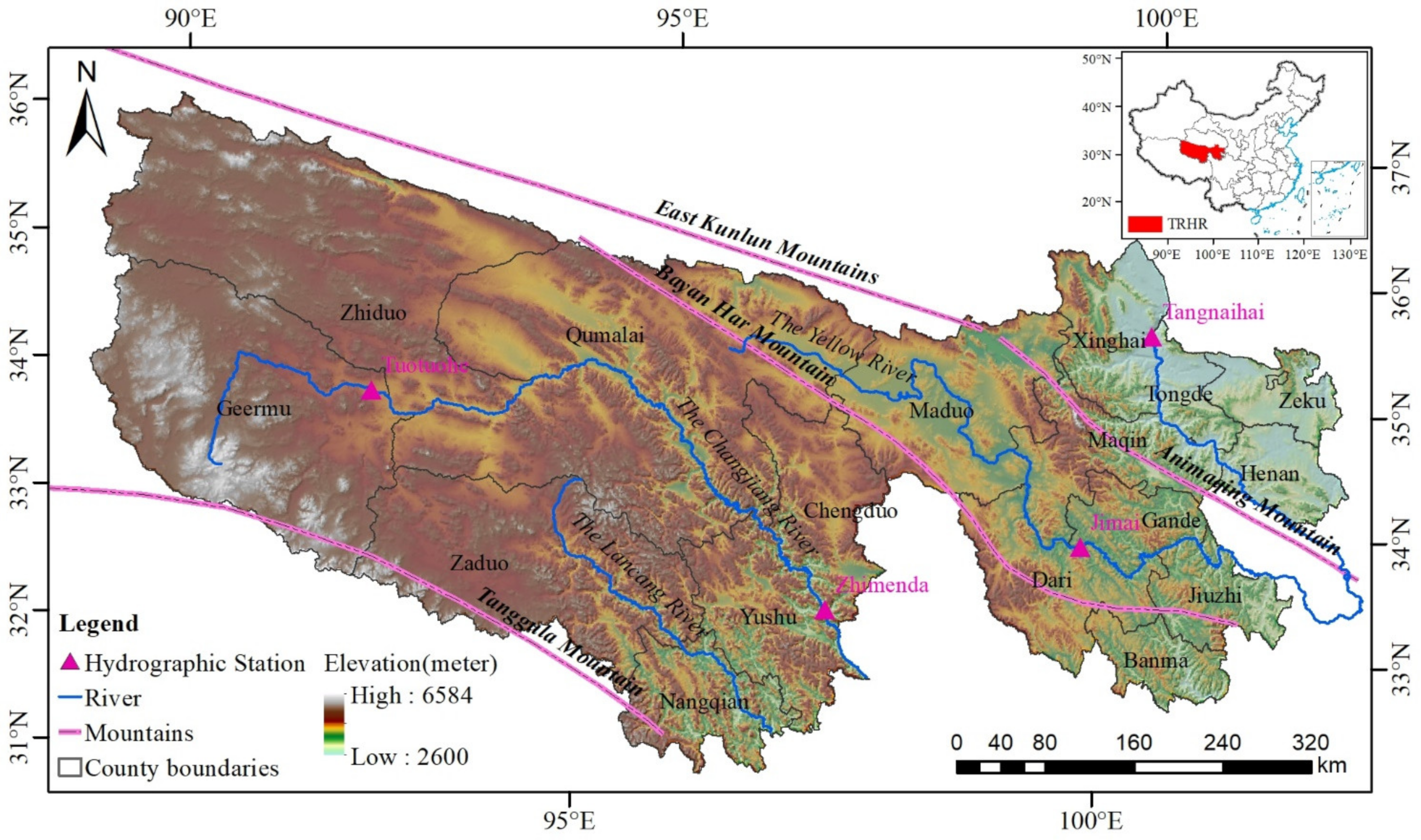
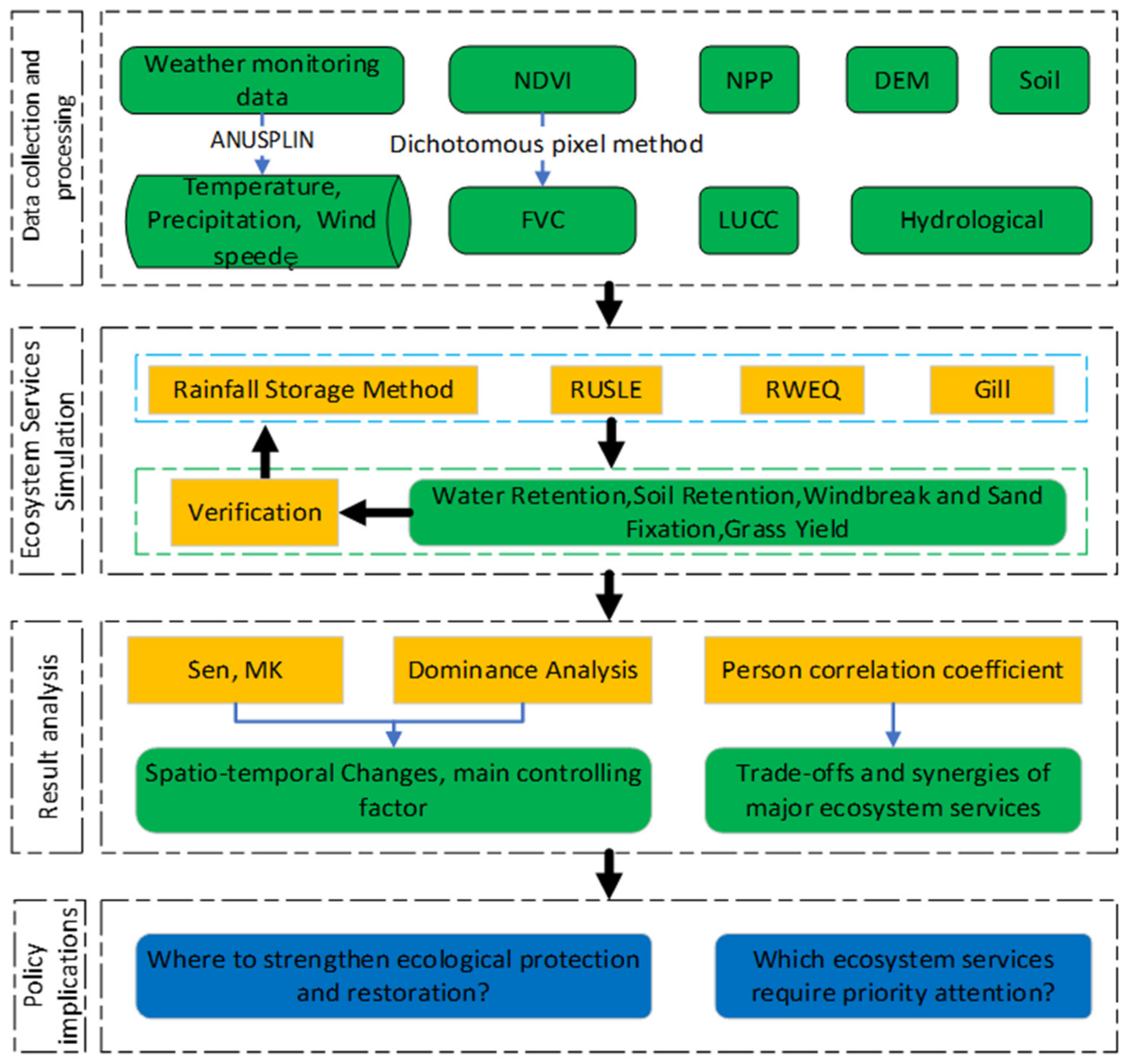
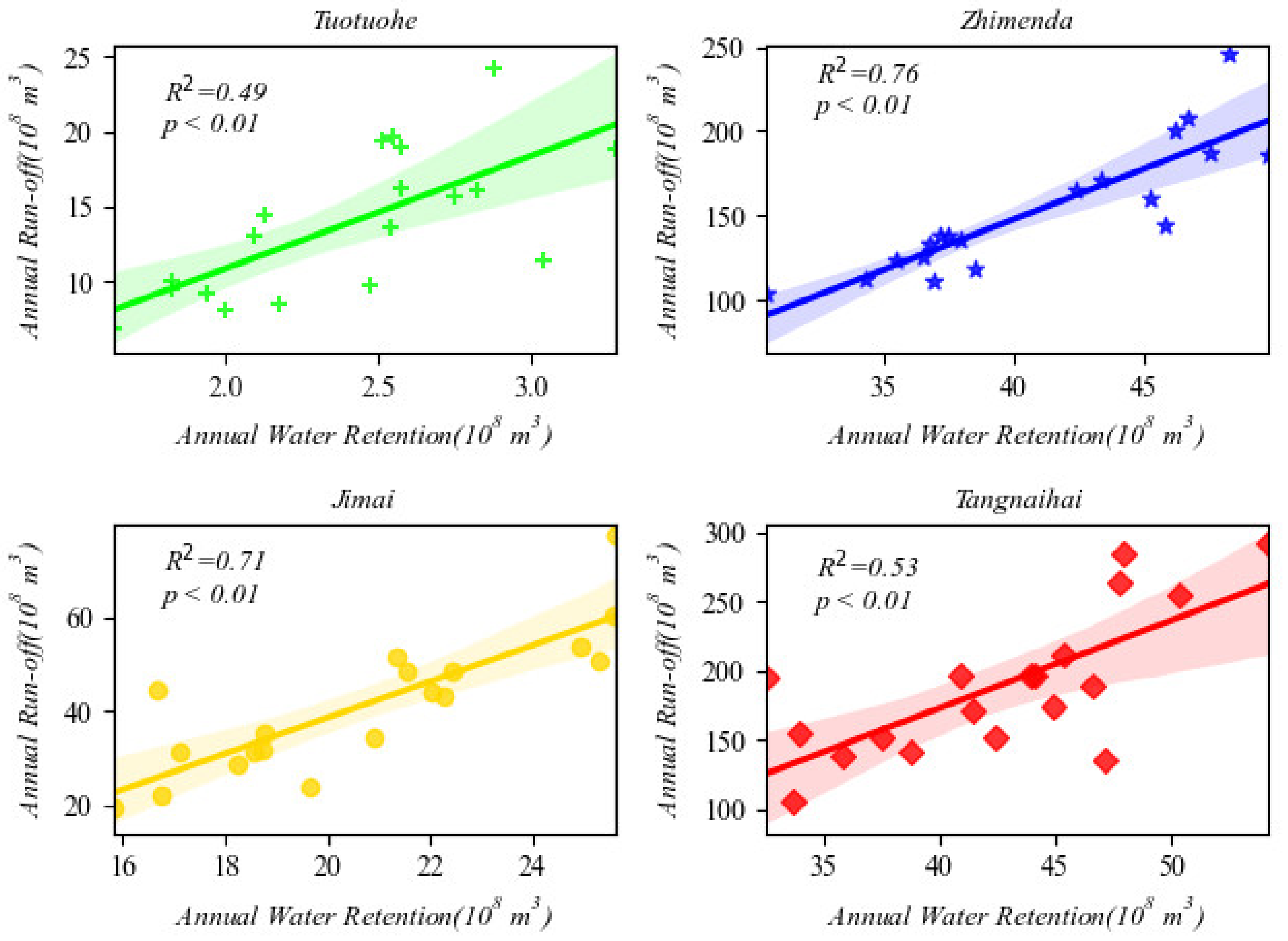
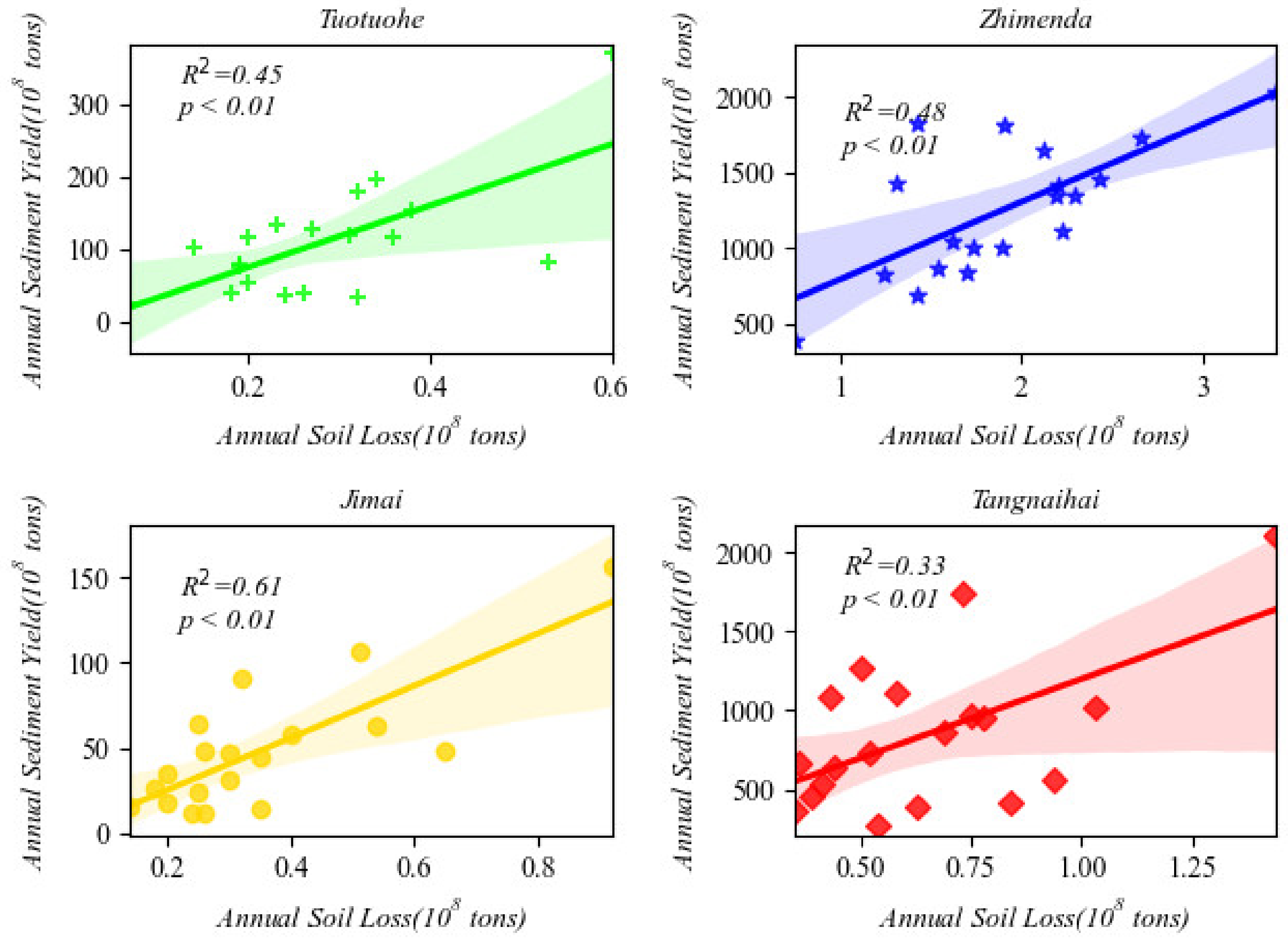
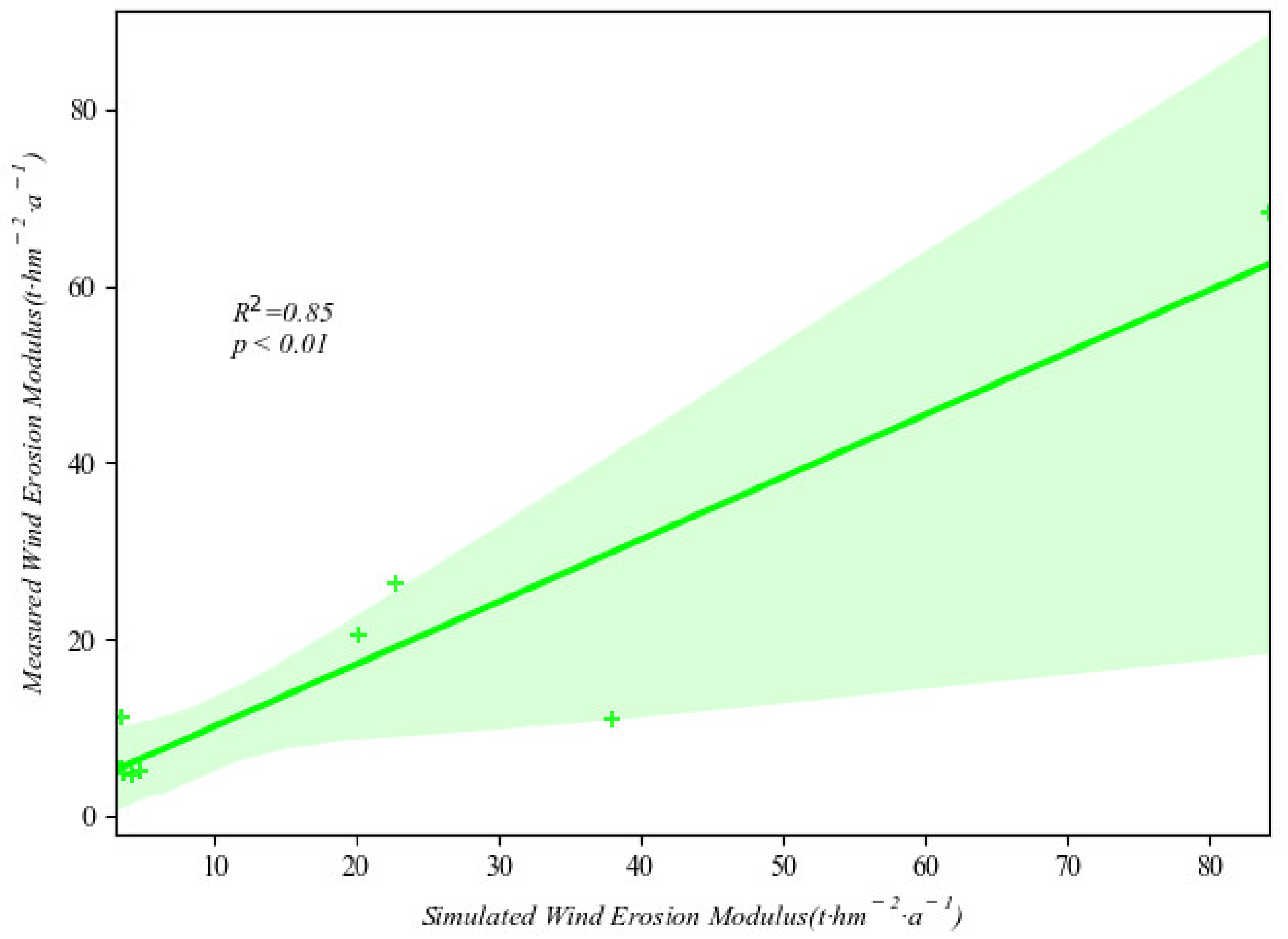
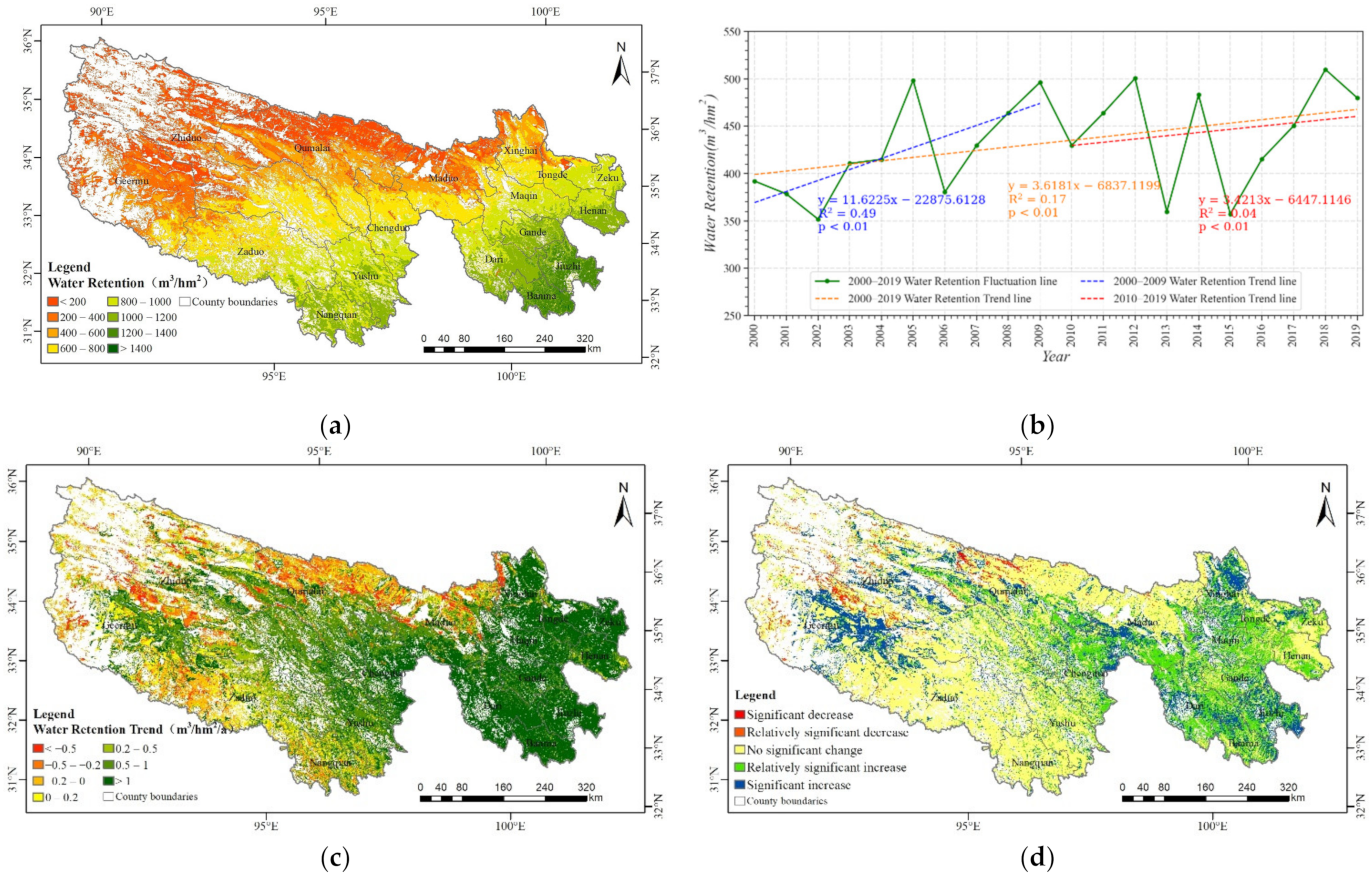
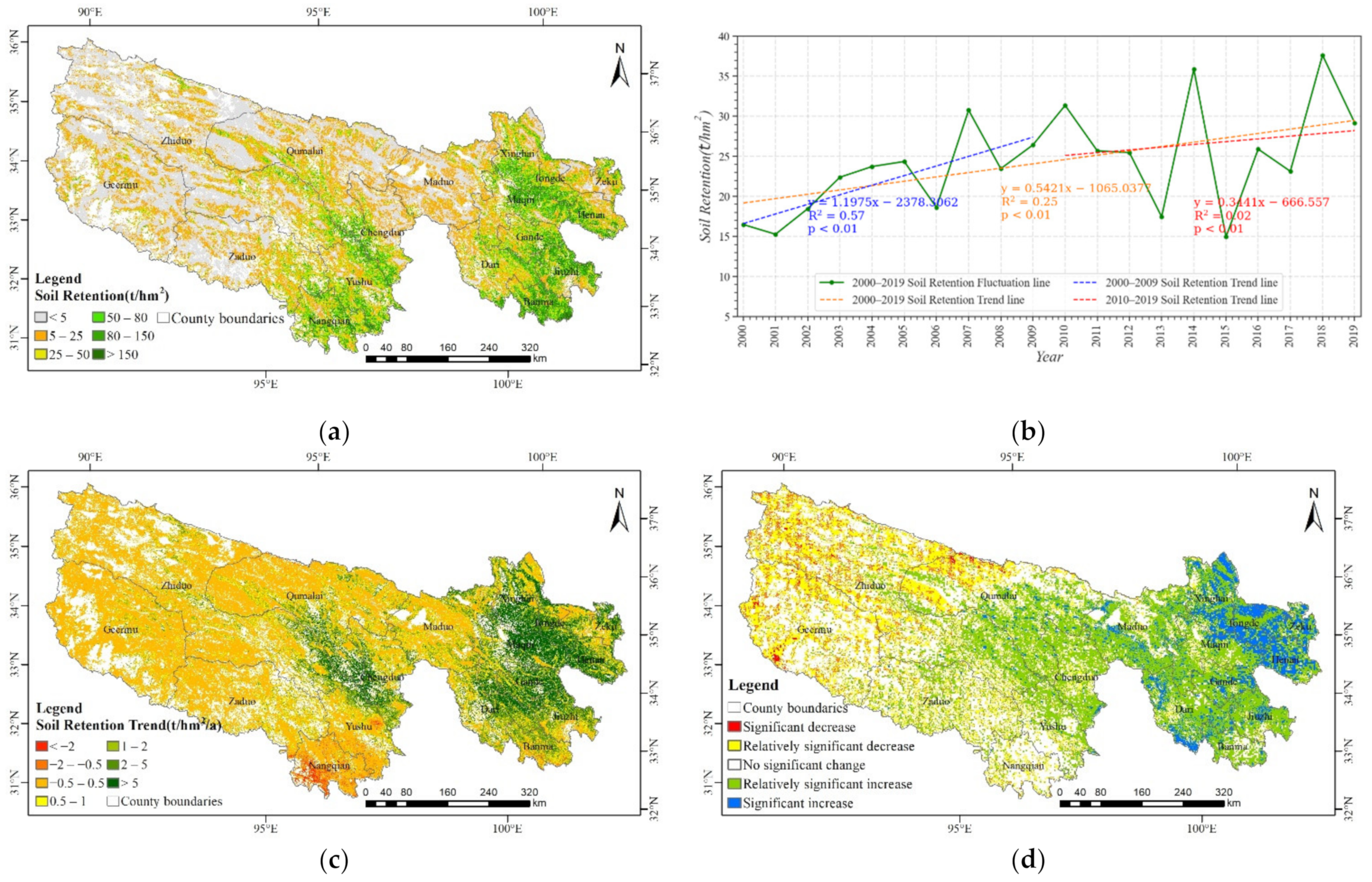



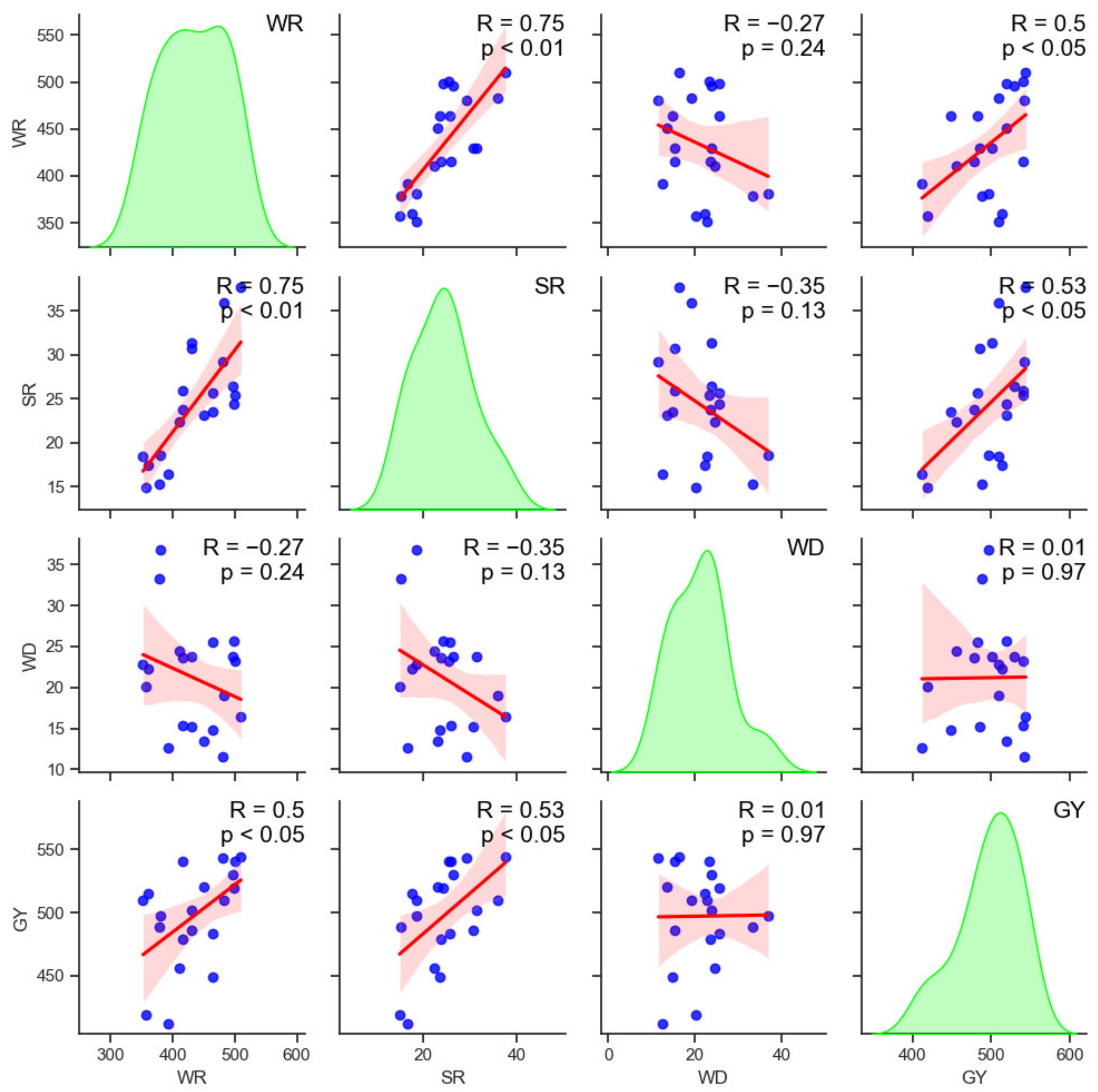


| Watershed | Hydrological Stations | Longitude | Latitude | Altitude (m) | Catchment Area (km2) |
|---|---|---|---|---|---|
| Headwater of the Yangtze River | Tuotuohe | 92°27′ | 34°13′ | 4535 | 15,924 |
| Zhimenda | 97°13′ | 33°02′ | 3546 | 137,704 | |
| Headwater of the Yellow River | Tangnaihai | 100°12′ | 35°34′ | 2770 | 121,972 |
| Jimai | 99°39′ | 33°46′ | 4135 | 45,019 |
| Grass Type | The Aboveground Biomass Ratio |
|---|---|
| Alpine meadow | 7.25 |
| Alpine steppe | 9.75 |
| Alpine desert | 3.29 |
| Temperate steppe | 3.27 |
| Significance Types | Sen Trend Value | MK p Value |
|---|---|---|
| Significant decrease | <0 | p < 0.05 |
| Relatively significant decrease | <0 | 0.05 ≤ p ≤ 0.1 |
| No significant change | Valid range | 0.1 < p |
| Relatively significant increase | >0 | 0.05 ≤ p ≤ 0.1 |
| Significant increase | >0 | p < 0.05 |
Publisher’s Note: MDPI stays neutral with regard to jurisdictional claims in published maps and institutional affiliations. |
© 2022 by the authors. Licensee MDPI, Basel, Switzerland. This article is an open access article distributed under the terms and conditions of the Creative Commons Attribution (CC BY) license (https://creativecommons.org/licenses/by/4.0/).
Share and Cite
Liu, G.; Shao, Q.; Fan, J.; Ning, J.; Huang, H.; Liu, S.; Zhang, X.; Niu, L.; Liu, J. Spatio-Temporal Changes, Trade-Offs and Synergies of Major Ecosystem Services in the Three-River Headwaters Region from 2000 to 2019. Remote Sens. 2022, 14, 5349. https://doi.org/10.3390/rs14215349
Liu G, Shao Q, Fan J, Ning J, Huang H, Liu S, Zhang X, Niu L, Liu J. Spatio-Temporal Changes, Trade-Offs and Synergies of Major Ecosystem Services in the Three-River Headwaters Region from 2000 to 2019. Remote Sensing. 2022; 14(21):5349. https://doi.org/10.3390/rs14215349
Chicago/Turabian StyleLiu, Guobo, Quanqin Shao, Jiangwen Fan, Jia Ning, Haibo Huang, Shuchao Liu, Xiongyi Zhang, Linan Niu, and Jiyuan Liu. 2022. "Spatio-Temporal Changes, Trade-Offs and Synergies of Major Ecosystem Services in the Three-River Headwaters Region from 2000 to 2019" Remote Sensing 14, no. 21: 5349. https://doi.org/10.3390/rs14215349
APA StyleLiu, G., Shao, Q., Fan, J., Ning, J., Huang, H., Liu, S., Zhang, X., Niu, L., & Liu, J. (2022). Spatio-Temporal Changes, Trade-Offs and Synergies of Major Ecosystem Services in the Three-River Headwaters Region from 2000 to 2019. Remote Sensing, 14(21), 5349. https://doi.org/10.3390/rs14215349









